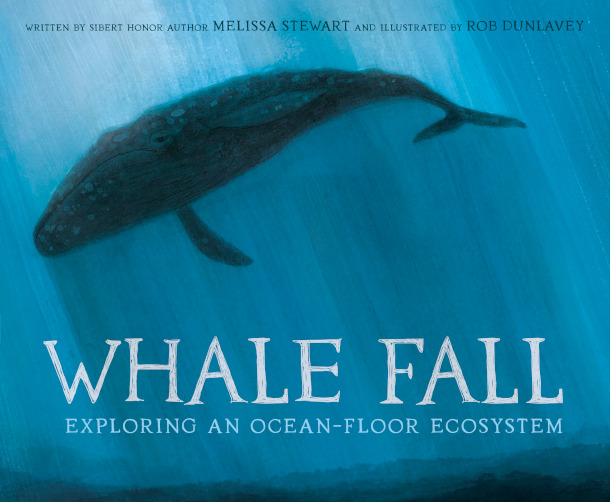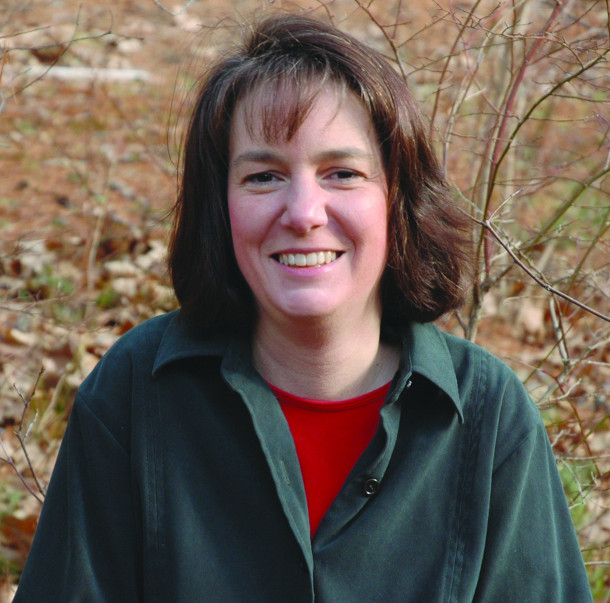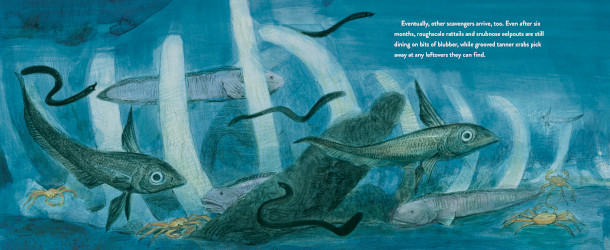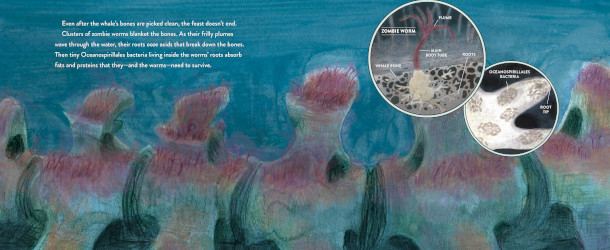The Life of a Dead Whale Fall
Air Date: Week of May 26, 2023

“Whale Fall: Exploring an Ocean-Floor Ecosystem” is the new book written by Melissa Stewart and illustrated by Rob Dunlavey. (Photo: Courtesy of Random House)
When a whale dies, it eventually sinks to the ocean floor. And although that whale’s life is over, that’s when a whole new circle of life kicks off, with thousands of organisms including hagfish, zombie worms, and octopuses feeding off this “whale fall” for 50 or more years. Children’s author Melissa Stewart wrote about this ecosystem in her book, “Whale Fall: Exploring an Ocean-Floor Ecosystem,” and joins Host Jenni Doering to discuss.
Transcript
CURWOOD: When a whale dies, it eventually sinks to the ocean floor. And although that whale’s life is over, that’s when a whole new circle of life kicks off. For fifty or more years, the whale’s meat, blubber, and bones feed thousands of other organisms including hagfish, zombie worms, octopuses and more. Scientists only started documenting these ocean-floor ecosystems, called “Whale Falls,” in the last few decades. The ocean is a huge place, and it can be harder to send a person to its deepest parts than into outer space. But when children’s author Melissa Stewart heard about these unique ecosystems she decided to write a book. Her 2023 volume is called “Whale Fall: Exploring an Ocean-Floor Ecosystem,” and Melissa Stewart joins me now to discuss. Welcome to Living on Earth!
STEWART: It's great to be here. Thanks for having me.
DOERING: So a whale fall starts with a death. But then it goes on to nourish a whole ecosystem of deep sea life. Can you tell us about sort of the process that happens over 50 years?

Melissa Stewart is the author of “Whale Fall: Exploring an Ocean-Floor Ecosystem,” as well as over 200 other books for children. (Photo: Courtesy of Melissa Stewart)
STEWART: Yeah, so a whale, like let's say a gray whale, can live for 70 years, but then when it falls to the ocean floor, it can fuel this community for another 50 or so years, and there are distinct phases of the decomposition process of the whale. So it will start out by attracting sleeper sharks, and also hagfish. They can smell the whale from miles around as it's laying there in the very early stages of the decomposition. And so they will do some of the initial feeding. And so you go through phases of different communities of creatures. And so there are crabs that come in, there are different kinds of fish that come in. And then there are also creatures that feed on the animals that are feeding on the whale fall. So for example, there can be just billions of little creatures called amphipods, which are sort of like shrimp. But then there are octopuses that come in and feed on those ampiphods, for example, but then as there gets to be less and less blubber less and less meat that are actually on the bones, then there are animals that come in and actually start to feed on the bones themselves. And so initially, animals like zombie worms, they release a substance that kind of will ooze into the bones. And they can get in and get nourishment out the bones, but they can only reach so far. And then there are even more creatures that will come in. So eventually, we get down to a stage where there's bacteria, and it will become a chemosynthetic ecosystem. And these deep sea microbes that are feeding on the whale fall will actually be housed inside of other creatures like clams and tubeworms that provide a home for these creatures, but also they are feeding on those little microbes themselves.
DOERING: So at first glance, this seems like kind of a morbid topic for a children's book. How did you come to choose a whale fall as the topic for your latest children's book?

The illustrations in Whale Fall help to teach children about this extraordinary ecosystem (Photo: Courtesy of Random House)
STEWART: The story behind this book traces back to an earlier book that I wrote, which is called, Ick: Delightfully Disgusting Animal Dinners, Dwellings and Defenses. And when I was researching that book, I was looking for animals that lived in really interesting environments that were somehow gross, unusual or disgusting. And so I came across zombie worms, which are also known as bone eating snot flower worms. So right there, you gotta have to just fall in love with that name, right? And I was so interested in the way that they live, they have such an unusual lifestyle. And one of the most interesting things about them is that the females are about one or two inches tall. They live on the bones of the whales as they're decaying. But the males are microscopic, and they live inside the female bodies.
DOERING: Wow. I've never even heard of creatures that live like that.

Thousands of different species are nourished by a whale fall such as roughscale rattails, snubnose eelpouts and tanner crabs. (Photo: Courtesy of Random House)
STEWART: Pretty amazing. And so as I was researching that book, and gathering all the information, I knew that I could only write about 400 words on zombie worms. And I had a lot more to say, not only about them, but also about this incredible environment that they live in. That was my access point into whale falls, and all the different creatures that live there. Thousands of different species can live at a whale fall during its 50 year life while the whale is decaying. And they have some of the most incredible names that you can imagine things like, rough scale rat tail and blob sculpin. And one of my favorites is sea pigs, which is a little sea cucumber, but it looks a lot like a pig. It's bright pink, and it has little feet like a pig. They're just, they're delightful little creatures. And I really wanted to write a book that focused on that ecosystem.
DOERING: Well, what inspired you to become a children's author and share stories about the environment with kids?

Even when only the bones remain, the whale fall continues to feed strange organisms that are able to break down the bones like zombie worms and their symbiotic bacteria (Photo: Courtesy of Random House)
STEWART: I think it really traces back to my family, to my parents, the way I was raised. When we were young, both my brother and I used to go out exploring and on walks. There was a national forest across the street from our house. So we had a lot of free rein to explore and discover. But when we went on these walks with my dad, he would always be asking us questions, to help nurture our curiosity about the natural world and what we were seeing around us. And I can remember one day, he took us to an area of the woods that we had never been to before. And he said, do you notice anything strange about the trees in this area? I noticed that all the trees seemed kind of small. And he said, great observation. The reason for that is because about 25 years ago, there was a fire in this forest. And all the trees burned down, many of the creatures had to run away and live in other parts of the wood. But over time, things have started to grow back and animals have returned. And that was a really powerful moment to me, because I was about eight years old. And it taught me two things. First of all, that the natural world is so powerful, that it can rejuvenate itself, that it can endure all kinds of calamities and rebound. But number two, it taught me that if you look around, you can read the history of a natural area through your observations. And that really hooked me. That was what made me want to become a scientist, and kind of launched me on a journey to discover as much as I can about the natural world and share it with other people.
DOERING: Melissa Stewart is the author of Whale Fall, as well as over 200 other science books for children. Melissa, thank you so much for joining us.
STEWART: Thanks for having me.
Links
NOAA | “What is a Whale Fall?”
Find the book “Whale Fall” (Affiliate link helps donate to LOE and local indie bookstores)
Living on Earth wants to hear from you!
Living on Earth
62 Calef Highway, Suite 212
Lee, NH 03861
Telephone: 617-287-4121
E-mail: comments@loe.org
Newsletter [Click here]
Donate to Living on Earth!
Living on Earth is an independent media program and relies entirely on contributions from listeners and institutions supporting public service. Please donate now to preserve an independent environmental voice.
NewsletterLiving on Earth offers a weekly delivery of the show's rundown to your mailbox. Sign up for our newsletter today!
 Sailors For The Sea: Be the change you want to sea.
Sailors For The Sea: Be the change you want to sea.
 The Grantham Foundation for the Protection of the Environment: Committed to protecting and improving the health of the global environment.
The Grantham Foundation for the Protection of the Environment: Committed to protecting and improving the health of the global environment.
 Contribute to Living on Earth and receive, as our gift to you, an archival print of one of Mark Seth Lender's extraordinary wildlife photographs. Follow the link to see Mark's current collection of photographs.
Contribute to Living on Earth and receive, as our gift to you, an archival print of one of Mark Seth Lender's extraordinary wildlife photographs. Follow the link to see Mark's current collection of photographs.
 Buy a signed copy of Mark Seth Lender's book Smeagull the Seagull & support Living on Earth
Buy a signed copy of Mark Seth Lender's book Smeagull the Seagull & support Living on Earth

